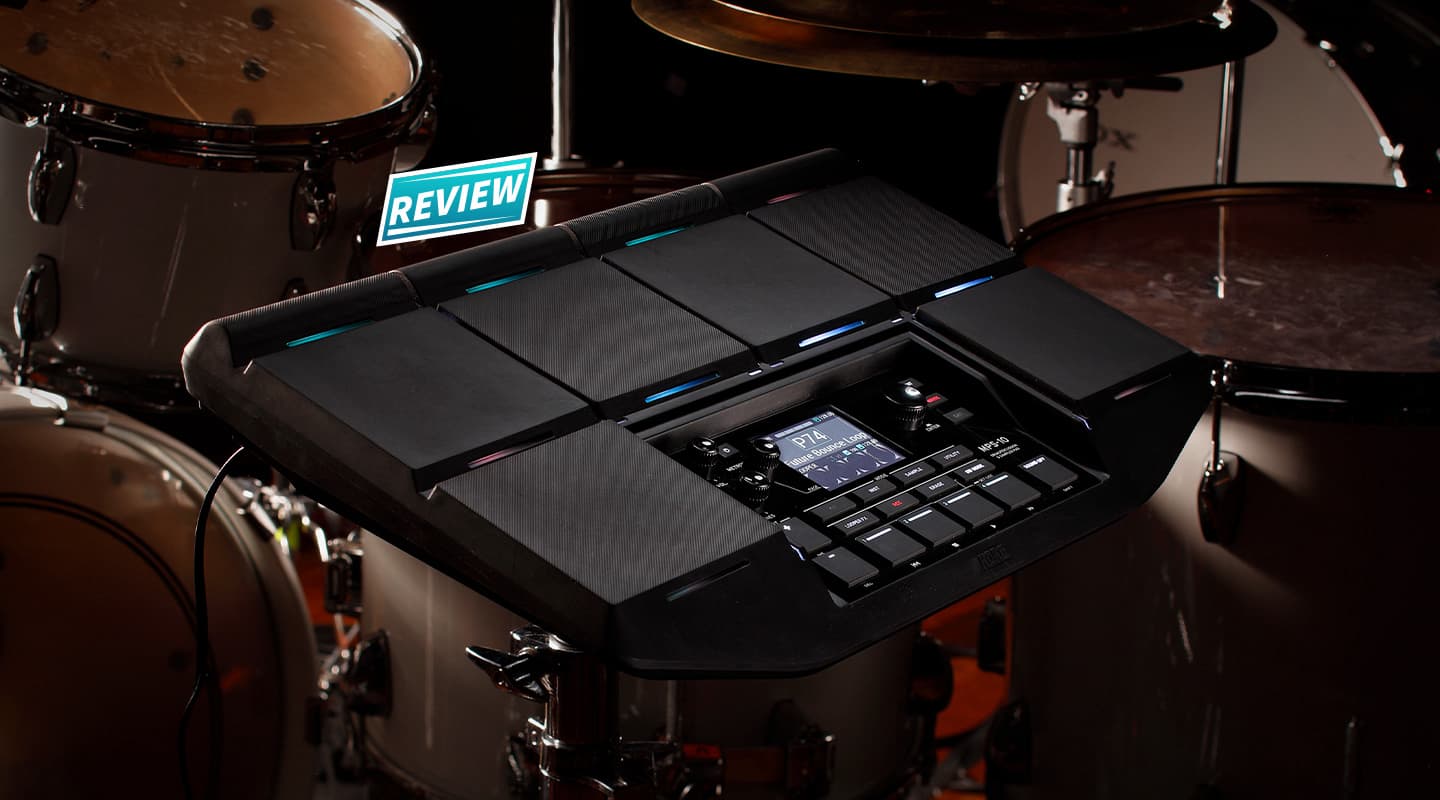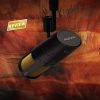
Review: Korg MPS-10
We give Korg’s new drum pads some stick. A hit or miss?
You can’t talk about Korg’s new MPS-10 without acknowledging Roland’s SPD, which has ruled the drum pad roost since 1985. So the question to Korg is: ‘why now?’. Why compete in a space that it’s left to its long-time rival for decades?
The answer would be, I’d guess, is that Korg thinks it can do it better.
But has it?
RIDING THE WAVE
You can’t talk about the MPS-10 without acknowledging that this isn’t Korg’s first rodeo. Back in the mid ’90s, Korg released the Wavedrum. It was unkindly dubbed the Korg Toilet Seat and didn’t enjoy the flush of success Korg was hoping for, but, in its defence, the Wavedrum played a key role in the evolution of physical modelling synthesis product development.
Interestingly, some of the key members of the MPS-10 R&D team trace their roots back to the Wavedrum. In other words, Korg has drum pad/drum trigger provenance, it’s not coming in cold.
FOR NON-DRUMMERS
I’m not a drummer but I was attracted to the MPS-10 as I was looking for a drum performance instrument that could accompany electronic music arrangements.
‘Live drums’ are an important part of any live music experience, even if they’re only triggers and not acoustic. The theatrical aspect of live drumming is highly engaging. Take a band like Rufus du Sol: drums and drum pads play a key role in their live performances and are all the better for it – finger drumming just won’t cut it.
As a non-drummer I found the MPS-10 experience rewarding. It’ll take you places you wouldn’t otherwise go, either by drawing a rhythm on a grid or bashing it out on a keyboard controller. There’s certainly more nuance and subtlety available.
FOR DRUMMERS
My adult daughter is a drummer and also found playing the MPS-10 to be a rewarding experience. There was an immediate connection with the instrument. Naturally she was able to squeeze far more sophistication out of the MPS-10 than I could and after a bit of mix ’n’ matching of sounds to pad locations she was producing interesting and unexpected results. The pads offer the right amount of responsiveness and are easy to find under your stick when in full flight. If you change kits mid flow, you won’t hear sounds being cut off in the transition, which is a classy (and very welcome) feature.
NEED TO KNOW
Korg MPS-10
Drum Percussion & Sampler Pad
KEPT IN THE LOOP
I’ll cut/paste the MPS-10 specs at the bottom of the review. But suffice it to say, there’s about the same number of kits and sounds as the SPD competition. About the same amount of RAM for sampling your own sound and about the same kinda complement of I/O.
The MPS-10 squeezes two more pads into its format by shrinking the editing/control section down to the bare minimum.
That said, editing the MPS-10 is reasonably straight forward, thanks to a good screen and sensible editing/control hierarchy. But remember, this is a performance instrument and once you’ve built your own kit (or modified an existing one), the time spent noodling under the bonnet is minimal compared to a synth. By which I mean, I’m happy to trade the space (and perhaps some ease of use) for extra pads.
The performance controls are bigger and easily negotiated. The loop section is a good example: recording a loop is dead easy and fun. The four-track looper is a big drawcard and enhances the MPS-10’s performance credentials. Busker-style, you can build a complex drum loop one track at a time, then mute, delete, re-record to your heart’s content. If you grow attached to the results, then it’s possible to export your loop as a WAV.
SELF CONTAINED
The sound set is good. Again, bear in mind, the MPS-10 isn’t attempting to replace a drum kit or indeed a high quality electronic drum kit. Many who are considering an MPS-10 purchase will see it as a sample playback device (just pop a USB stick of your samples into the back) and in this regard the MPS-10 will serve you well.
Furthermore, there are plenty of high quality effects on offer, both global and insert effects. The MPS-10 is certainly a self-contained instrument that has all it needs to join any group without needing any additional sonic assistance.
Korg didn’t invent shoulder pads but it has the dress sense to know how best to use them


SHOULDERING THE LOAD
I mentioned at the top that Korg wouldn’t join the drum pad fray without reason to believe it had an ace or two up its sleeve.
Turns out it has shoulder pads up its sleeve. In fact, you won’t find better shoulder pads since the ‘Who Shot JR Ewing?’ episode of Dallas.
Korg has identified the four elongated pads as an ideal way of adjusting MIDI CC messages. Keyboardists have always had pots and faders, now drummers can have the MPS-10 shoulder pads.
When engaged, the onboard colour-changing LEDs act as an indicator as to the status (128 steps) of your chosen MIDI CC. It might be tuning… which is really useful but obvious. Or it could be any other MPS-10 editing parameter. By hitting the shoulder pads you can control the amount of reverb on your snare in real time, or the panning of your side stick, or, or, or… use your imagination.
Sure, Korg didn’t invent the idea of shoulder pads but it has the dress sense to know how best to use them.
TAKE A POUNDING
The MPS-10 instantly impresses as a well-built unit that can and will cop a beating. Korg assures us it’s done its homework and has the blessing of pro drummers who have done their best to belt the life out of it. Nothing about the MPS-10 would cause me to suspect otherwise.
The MPS-10 certainly competes in the traditional SPD market, ie. as a drummer’s electronic add-on to play samples and electronic kit sounds. Players will appreciate the layout and strike detection.
The four-track looper opens up the MPS-10’s vistas to jamming and performance, which will make it a rehearsal room favourite – if Ed Sheeran was a drummer, I’ve no doubt he’d be all about the MPS-10.
For the studio producer with everything, the MPS-10 will be a welcome addition. Certainly they’ll appreciate the playability and improved drum programming sophistication it offers – more as a controller than as a sound source.
I’ve referenced the category’s OG, the SPD (the SX-Pro currently carries the SPD torch for Roland) which is the MPS-10’s closest competitor, but there are other (thriftier) players in this market, including offerings from Yamaha, Alesis, and Nord. That said, the MPS-10 has those aforementioned extras that will be hard to resist for those serious about performance.
FEATURES
- 10 pads
- Preloaded sound source
- Versatile sampler
- 4 CC shoulder pads
- Powerful 4-track looper
- External trigger IN jack, footswitch compatibility, and expression jack
- Collection of 2350 assignable Instruments (INST pads)
- More than 3000 high quality samples
- 100 preset kits, each comprising 10 INST pads
- Master reverb and filter
- Smooth Sound Transition (SST)
- Seamlessly integrate your favourite sounds from a USB flash drive
- Three-colour LEDs illuminating each pad
- User-friendly MPS-10 Editor web app
- Developed by the design team behind WaveDrum and Pearl e/MERGE






















RESPONSES